Topline: Our electric grid performed well during a hot summer despite several power plants retiring. But now is the time to dust off a great tool of reliability: clean, green, cost-saving energy efficiency.
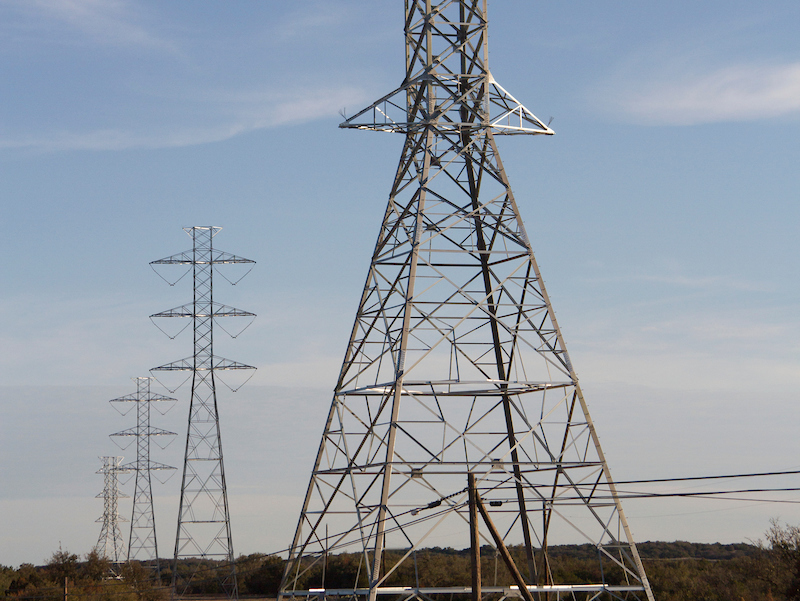
Image: Al Braden Photography
By Cyrus Reed
This Summer was a test of our electric grid in Texas, and thankfully, we passed. Many policymakers and utility regulators were concerned that another unusually hot summer would max out our energy resources and result in price spikes or cause blackouts. Those things didn’t happen, but to help ensure they won’t happen in the future, policymakers need to look at all the options on the table. One option that has not gotten enough attention is clean, green, money-saving, energy efficiency.
First, a few quick reminders. About 90% of the power used in Texas is contained within a grid called “ERCOT” (Electric Reliability Council of Texas). The rest of it is divided between the Western Interconnect (think El Paso), the Southwest Power Pool (think the panhandle and part of north Texas) and the Southeastern Electricity Reliability Council (think northeast Texas).
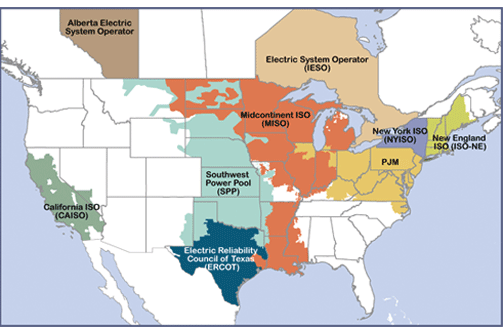
Also, remember that Texas uses more electricity than any other state, which is not surprising given our large industrial base, hot weather, and population.
Do we have enough power?
The first question you may have when you think about Texas not having enough power to meet demand is, should we build more power plants? It’s fair to ask that question. It’s instinctual. It would help resolve and capacity shortage should it occur. After some thought, and some research, you might ask a second question, are we wasting power? The short answer is, yes. We are wasting a lot of power in Texas.
Texas has the potential to be so much more efficient with how we use energy. The Department of Energy recently released their assessment of energy efficiency potential by state and found that Texas had more energy efficiency potential than any other state (about 87.3 million MWh between now and 2035), and could be saving roughly 19% of our energy use if we were to really implement energy efficiency on a large scale.
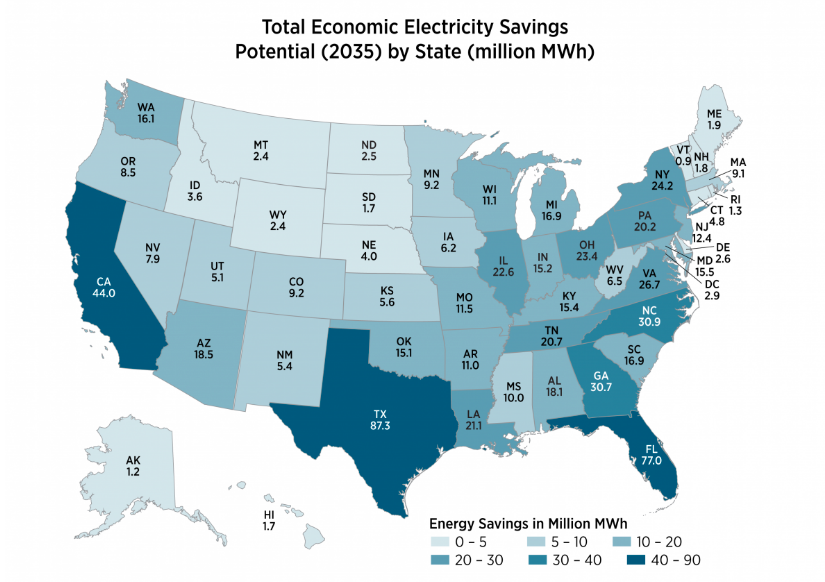
The American Council for an Energy Efficiency Economy (ACEEE) issues an annual report rating each state for their energy efficiency policies and programs, and Texas sits smack dab in the middle of the pack at #26. They found that we are saving only about 0.2 percent of our electricity use through energy efficiency programs, while states like California and Massachusetts are saving between 1.5 and 3.0 percent per year. Among states, that have an EERS - an energy efficiency resource standard - ACEEE rates Texas dead last, in large part because the state has not expanded the goal since 2011, and leading states are now achieving goals of one, two or even three percent.
Where is Texas wasting energy?
If there’s a lot of energy efficiency potential out there, where is it? How are we wasting energy? What do energy efficiency policies look like?
Here are a few examples:
• Leaky buildings - New construction, at a minimum, is supposed to meet the 2015 International Energy Conservation Codes (or equivalent codes). These building codes set the standards for the amount of insulation, good windows, lighting, and installing the right size air conditioning systems among other provisions. A home built to our current state standard is about 15% more energy efficient than a home built to the previous state minimum (the 2009 IECC), which is about 15% more efficient than a building built to the 2001 standard. Our new residential and commercial buildings are just more efficient and use less energy assuming they comply with these new standards. But that means our older buildings are a whole lot less efficient, and electricity is wasted, if they are not retrofitted to these standards.
• Utility energy efficiency programs - Since 2001, Texas has required private transmission and distribution companies (sometimes called TDUs, “poles and wires” or investor-owned utilities) to provide rebates and incentives for home and commercial energy efficiency improvements in their service territory. These programs can be designed to improve the efficiency of homes and businesses and the appliances in them..
• Appliances and devices - Dishwashers, lights, refrigerators, air conditioning systems, and televisions have all been improved to run better with less power, mainly through implementation of federal appliance standards. And then there are lightbulbs. The incandescent light bulb was replaced with the compact fluorescent bulb. And now the compact fluorescent bulb is being replaced by the light-emitting diode (LED) bulb. Five years ago, LED lights cost $50 and were hard to find. They cost $3 today or even less and are everywhere - Home Depot, Lowe’s, your local supermarket.
Since our building codes are reasonable up to date, and appliance standards are set at the federal level, let’s focus on energy efficiency programs run by (or through) utilities.
Energy efficiency goals and programs in Texas
Texas was the first state to have an energy efficiency resource standard (EERS) in 1999. Since then, the Legislature and Public Utility Commission have raised the goals TDUs must meet on three occasions. The last one was in 2011. So what is our state goal for energy efficiency?
0.4 percent of peak demand
Doesn’t sound like much, does it?
The nine largest TDUs in Texas must implement annual programs to meet at least 0.4 percent of peak demand through these incentive-based programs for both commercial and residential ratepayers. The programs are paid for by ratepayers through what is called the Energy Efficiency Cost Recovery Fee, which must be approved each year by the Public Utility Commission. While utilities can earn a bonus for exceeding their required goals, they must stay under cost caps established by the Commission, which are currently about $1.25 per month on an average customer’s bill.
So what how much power do those programs actually save?
In 2016, the nine TDUs reduced peak demand by nearly 400 MW and saved about 600,000 MWh of energy.
What about public power utilities?
While they are not mandated by the state to do it, most municipal electric utilities and electric cooperatives run their own programs and some of the leading utilities have much more robust programs than those required by state law for private utilities. In particular, Austin Energy and CPS Energy in San Antonio have been state leaders on energy efficiency goals and program with Austin Energy setting an annual one percent energy savings goal as well as a long-term demand reduction goals.
There are many more ways Texas can be more energy efficient. There are large scale industrial processes that use a lot of energy, for example. But when you look at what’s causing demand to spike, the focus on homes and businesses makes more sense.
Why focus on peak demand?
On one beautiful spring afternoon (March 24, 2016), total the maximum amount of power (load) used in ERCOT was 33,597 megawatts (MW), which was divided equally between large commercial and industry on one side of the pie chart, and residential and small commercial spaces on the other side. However, just a few months later on a hot afternoon (August 11, 2016), total peak load was about 37,000 MW higher (more than 70,000 MW total). The vast majority of this increase was due to the high loads from residential and small commercial air conditioning. In other words, half of our load on a hot summer afternoon is really just cooling the buildings we work and live in.
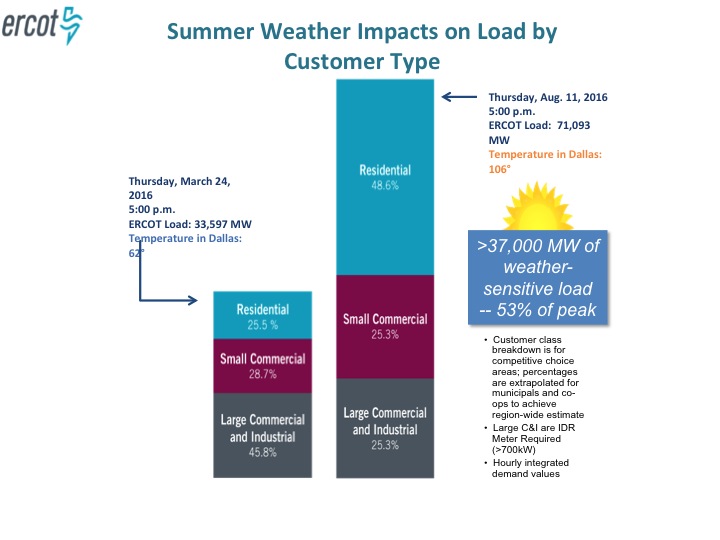
Winter weather can have a similar impact on our grid, mostly because of electric heating requirements of buildings. On a relatively mild morning of Thursday, November 16, 2017, at 7:15am electric demand was roughly 37,000 MW. On a cold morning in January, 2018, demand increased up to nearly 66,000 MW, virtually all of the increase due to heating our homes.
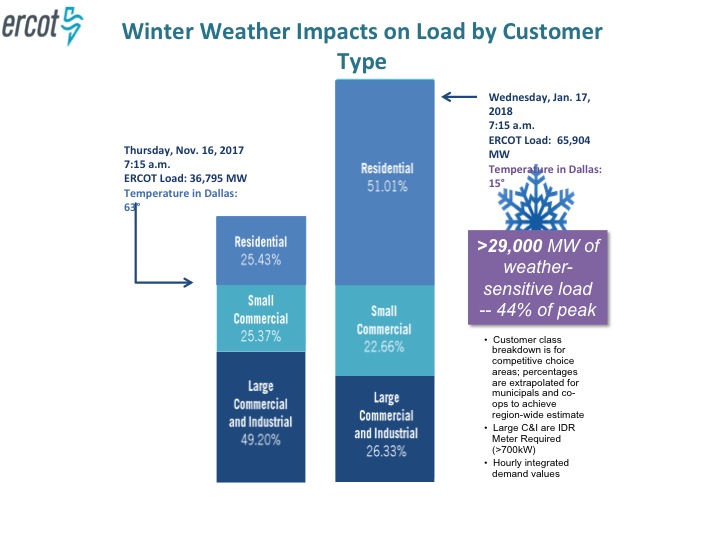
Thus, creating programs to lower overall energy use, and also to deal with shifting peak (high) use are key to lowering our need to run more expensive and polluting “peaker” plants. They would help clean our air, and create jobs for better insulation, windows, building and more efficient heating and air conditioning systems. Shifting peak use through demand response - controllable thermostats and other “smart” lighting and appliance controls - and the use of electric and thermal storage, would also help shift our peak.
Sierra Club’s position
It’s time to review and update our current energy efficiency rule at the Public Utility Commission. It’s far too modest. We need to include both peak demand goals and a corresponding energy savings goal. The rule is now many years old. Technologies have changed and new opportunities have emerged. For many years, the Sierra Club has believed that a one percent energy savings goal is achievable, cost-effective and would help all energy customers, particularly as a way to avoid major changes to our energy-only market, which becomes stressed during peak hours.
Municipal utilities and electric cooperatives should also do their part. While they are required to report their savings to the State Energy Conservation Office (SECO), most of these utilities have very basic programs that could be expanded through local action. Setting a one percent goal for these utilities could be a step in the right direction.
Other public entities (city and county governments, school districts and universities) should also put time and money into reducing their energy use. While many of these entities are required by state law to report on their energy use - and their plans to reduce energy use - most have not actually taken real actions to put these plans into reality. But there are utility rebates, programs, low-interest financing from SECO, and even some federal funding opportunities to do much, much more.
The legislature could increase reporting requirements and require them to actually implement those plans if they refuse to do so on their own.
Here are some helpful links to SECO to learn more:
https://comptroller.texas.gov/programs/seco/funding/ (Loans)
https://comptroller.texas.gov/programs/seco/programs/local/ (Local govt programs)
https://comptroller.texas.gov/programs/seco/programs/schools/ (School programs)
Finally, ERCOT should pursue efforts to allow demand response - literally shifting energy use away from peak demand - to actually compete in the real-time market and be paid. This will require competitive retail energy providers - or even third-party demand response companies - to get involved, and for ERCOT to change some rules to allow this to happen. Stay tuned for how ERCOT could actually get this done!